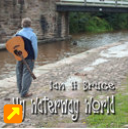The Bugsworth Tipplers
by Ian H Bruce (2009)
Recorded by Ian H Bruce
Riding the wagons as they rattle down the way
Dove Holes to Bugsworth, day after day
Lurching from side to side, sparks flying far and wide
Dangers ignored for a waggoner’s pay
Nipper and me we stand on the lily-pins*
Brake hooks in hands for spragging* the wheels
Thrown at the right time, to stop forty tons of lime
Make one mistake and we’re head over heels
Men climbing spokes turn the tipplers of Bugsworth
Wagons raised high drop their loads to the ground
Ironwork red with rust, covered in white lime dust
Horse drawn barges leaving – Manchester bound
Steering a pleasure boat, enjoying the sunshine
Marple to Bugsworth, on a Bank Holiday
‘Nice day’ it is the cry as we greet passers-by
Some pints in 'The Sportsman' and then on our way
All’s quiet and serene as we cruise into Bugsworth
Unlike times past with the toil, sweat and din
No more the inland port built for limestone transport
The only tipplers now are in the old ‘Navvy’ Inn
Fair weather boaters meet in the public bar
Beneath faded photos of an industry past
Iron rails and tipplers gone, a basin long overgrown
Now a heritage site neatly laid out to grass
So relax and enjoy the beauty of Bugsworth
But raise up a glass to those tipplers of yore
To the gangers, the nippers, the lime wagon tippers
The boaters and all those who’ve drunk here before
Bugsworth Basin stands at the end of the Peak Forest Canal and was at one time reputedly the country's largest
inland port. It was the place where limestone, brought down on waggons on the Peak Forest Tramway from the
quarries around Dove Holes, was loaded into barges. These then carried the limestone to destinations further afield.
One of the features of Bugsworth Basin at that time was a large wheel or 'tippler' used to overturn the limestone
waggons to unload their contents.
When I first saw Bugsworth Basin it was in the early stages of the re-vitalisation process being brought about by
members of the IWPS. At that time I was a boatless rambler. Little did I think that thirty years later I would be a
regular visitor by boat. Over the years many may have thought that boats would never return, particularly when
tremendous leakage problems were encountered. Nevertheless it is now open and well worth a visit, thanks chiefly to
the voluntary efforts of many enthusiasts.
* The 'lily' pins were the ends of the waggon axles upon which the ganger and his nipper would stand in order to use
the brake chain. This was a short chain with hooks at each end. One hook went over the side of the waggon and the
other was used to 'hook' a wheel spoke and bring the wheel to a stop. This primitive and very dangerous method of
stopping the waggon train was known as 'spragging'.
An exciting Virtual Bugsworth Museum is currently being developed with its own YouTube channel. Keep an eye open
for the uploading of fascinating footage via this video link. Watch on YouTube for full list of links.
The song is recorded on :





The Bugsworth Tipplers
by Ian H Bruce (2009)
Recorded by Ian H Bruce
Riding the wagons as they rattle down the way
Dove Holes to Bugsworth, day after day
Lurching from side to side, sparks flying far and wide
Dangers ignored for a waggoner’s pay
Nipper and me we stand on the lily-pins*
Brake hooks in hands for spragging* the wheels
Thrown at the right time, to stop forty tons of lime
Make one mistake and we’re head over heels
Men climbing spokes turn the tipplers of Bugsworth
Wagons raised high drop their loads to the ground
Ironwork red with rust, covered in white lime dust
Horse drawn barges leaving – Manchester bound
Steering a pleasure boat, enjoying the sunshine
Marple to Bugsworth, on a Bank Holiday
‘Nice day’ it is the cry as we greet passers-by
Some pints in 'The Sportsman' and then on our way
All’s quiet and serene as we cruise into Bugsworth
Unlike times past with the toil, sweat and din
No more the inland port built for limestone transport
The only tipplers now are in the old ‘Navvy’ Inn
Fair weather boaters meet in the public bar
Beneath faded photos of an industry past
Iron rails and tipplers gone, a basin long overgrown
Now a heritage site neatly laid out to grass
So relax and enjoy the beauty of Bugsworth
But raise up a glass to those tipplers of yore
To the gangers, the nippers, the lime wagon tippers
The boaters and all those who’ve drunk here before
Bugsworth Basin stands at the end of the Peak Forest Canal and
was at one time reputedly the country's largest inland port. It was
the place where limestone, brought down on waggons on the Peak
Forest Tramway from the quarries around Dove Holes, was loaded
into barges. These then carried the limestone to destinations further
afield. One of the features of Bugsworth Basin at that time was a
large wheel or 'tippler' used to overturn the limestone waggons to
unload their contents.
When I first saw Bugsworth Basin it was in the early stages of the re-
vitalisation process being brought about by members of the IWPS. At
that time I was a boatless rambler. Little did I think that thirty years
later I would be a regular visitor by boat. Over the years many may
have thought that boats would never return, particularly when
tremendous leakage problems were encountered. Nevertheless it is
now open and well worth a visit, thanks chiefly to the voluntary
efforts of many enthusiasts.
* The 'lily' pins were the ends of the waggon axles upon which the
ganger and his nipper would stand in order to use the brake chain.
This was a short chain with hooks at each end. One hook went over
the side of the waggon and the other was used to 'hook' a wheel
spoke and bring the wheel to a stop. This primitive and very
dangerous method of stopping the waggon train was known as
'spragging'.
An exciting Virtual Bugsworth Museum is currently being developed
with its own YouTube channel. Keep an eye open for the uploading of
fascinating footage via this link. Watch on YouTube for full list of
links.
The song is recorded on :






















